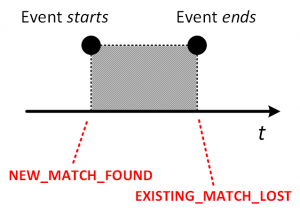Notice: This Wiki is now read only and edits are no longer possible. Please see: https://gitlab.eclipse.org/eclipsefdn/helpdesk/-/wikis/Wiki-shutdown-plan for the plan.
VIATRA/CEP/Semantics
Contents
Event representation semantics
Depending on whether events have a length attribute in the time dimension (i.e. a duration) associated with them, we distinguish between two fundamental event representation semantics:
- Point and
- Interval semantics.
In point-like representation, events are depicted as points on the time line, with no duration; i.e. only the occurrence of the event can be detected. In contrast, the interval semantics-based representation depicts both the appearance and the disappearance of an event and hence, assigning a duration attribute to it.
The VIATRA-CEP framework, and the VEPL language in particular, uses point semantics to represent simple atomic events. Although, in the special case of Query result change event patterns, both point and interval semantics can be used and that in a very intuitive way: via the optional queryResultType attribute of Query result change event patterns.
Setting the queryResultType to NEW_MATCH_FOUND or EXISTING_MATCH_LOST, one can define an event pattern on the appearance or the disappearance of a graph pattern, respectively.
- If there are event patterns defined for both ends, interval semantics is used, essentially.
- If the optional parameter is not used, point semantics is used.
- If only one of the NEW_MATCH_FOUND and EXISTING_MATCH_LOST values is used, so-called quasi-point semantics is used. In this case the runtime watches both ends of the interval, but only triggers actions on the appropriate end.


